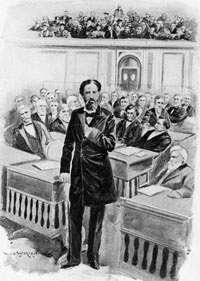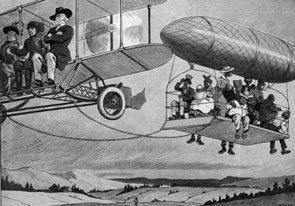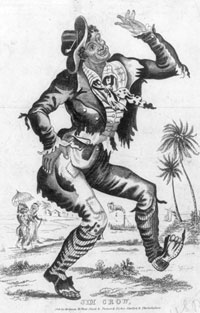The Negroes’ Temporary Farewell
Jim Crow and the Exclusion of African Americans from Congress, 1887–1929
Introduction
 John M. Langston took his seat in Congress after contesting the election results in his district. One of the first African Americans in the nation elected to public office, he was clerk of the Brownhelm (Ohio) Township in 1855.John Mercer Langston, From the Virginia Plantation to the National Capitol (Hartford, CT: American Publishing Company, 1894)
John M. Langston took his seat in Congress after contesting the election results in his district. One of the first African Americans in the nation elected to public office, he was clerk of the Brownhelm (Ohio) Township in 1855.John Mercer Langston, From the Virginia Plantation to the National Capitol (Hartford, CT: American Publishing Company, 1894)On December 5, 1887, for the first time in almost two decades, Congress convened without an African-American Member. “All the men who stood up in awkward squads to be sworn in on Monday had white faces,” noted a correspondent for the Philadelphia Record of the Members who took the oath of office on the House Floor. “The negro is not only out of Congress, he is practically out of politics.”1 Though three black men served in the next Congress (51st, 1889–1891), the number of African Americans serving on Capitol Hill diminished significantly as the congressional focus on racial equality faded. Only five African Americans were elected to the House in the next decade: Henry Cheatham and George White of North Carolina, Thomas Miller and George Murray of South Carolina, and John M. Langston of Virginia. But despite their isolation, these men sought to represent the interests of all African Americans. Like their predecessors, they confronted violent and contested elections, difficulty procuring desirable committee assignments, and an inability to pass their legislative initiatives. Moreover, these black Members faced further impediments in the form of legalized segregation and disfranchisement, general disinterest in progressive racial legislation, and the increasing power of southern conservatives in Congress.
In the decade after the 1876 presidential election, the Republican-dominated Reconstruction governments, which had provided the basis for black political participation in the South, slowly disintegrated, leaving the rights of black voters and political aspirants vulnerable to Democratic state governments controlled by former Confederates and their sympathizers. The electoral crisis of 1876 also revealed fissures within the GOP, as many party stalwarts focused on commercial issues rather than on the volatile racial agenda previously pursued by the Republicans. This period marked the beginning of a “multigenerational deterioration” of the relationship between black and white Republicans.2 By the 1890s, most Black Americans had either been barred from or abandoned electoral politics in frustration. Advocacy for blacks in Congress became substantially more difficult.3 After Representative White’s departure from the House in March 1901, no African American served in the U.S. Congress for nearly three decades. The length and persistence of this exile from national politics starkly conveyed the sweeping success of the system of racial segregation imposed upon blacks by law and custom, known widely as “Jim Crow.”
Jim Crow
During this era African Americans experienced unique suffering and deprivation. Beginning in the last quarter of the 19th century, blacks—the vast majority of whom still lived in the South—endured a system of racial segregation that circumscribed their political, economic, and social status. Distinguished historian of the South C. Vann Woodward explains that the removal of key “restraints” unleashed widespread, virulent racist social policies. Eroding northern liberal interest in fostering a biracial society in the South after 1877, the failure of southern conservatism to check race baiting politics, and the corresponding capitulation of the southern ruling class to rising white supremacist radicalism, each played a part in fashioning a uniquely American racial apartheid.4
 Foreshadowing the struggles of a half-century later, magazines like Puck Illustrated noted the inequities of Jim Crow transportation as early as 1913.Image courtesy of Library of Congress
Foreshadowing the struggles of a half-century later, magazines like Puck Illustrated noted the inequities of Jim Crow transportation as early as 1913.Image courtesy of Library of CongressJim Crow, a system of segregation enforced by legal and extralegal means, evolved over several decades.5 Jim Crow was a popular character in southern minstrel shows—in which white performers in blackface portrayed African Americans. How the term Jim Crow came to be associated with segregation is not clear, but it was eventually used to describe both the formal and the informal manifestations of segregation in the South. Beginning with Tennessee in 1870, every southern state adopted laws against interracial marriage. By the 1880s, most public places and many private businesses had Whites Only and Colored facilities. These included schools, seating areas, drinking fountains, work spaces, government buildings, train stations, hospitals, restaurants, hotels, theaters, barbershops, laundries, and even public restrooms.
Virtually all the political advances afforded freedmen during Reconstruction were rolled back and eradicated during the years after 1890. In the South, the races were separated even more systematically and rigidly than during slavery. Many blacks were reduced to a suppressed citizenship that was repeatedly exploited for political and economic purposes. As C. Vann Woodward writes, Jim Crow laws “did not assign the subordinate group a fixed status in society. They were constantly pushing the Negro farther down.”6
Footnotes
- “The Negro in Politics,” 12 December 1887, Washington Post: 5.
- Michael K. Fauntroy, Republicans and the Black Vote (Boulder, CO: Lynne Rienner Publishers, 2007): 41.
- C. Vann Woodward, The Strange Career of Jim Crow (New York: Oxford University Press, 2002): 82.
- Woodward, The Strange Career of Jim Crow: 69.
- A rich historical literature details this process. Aside from The Strange Career of Jim Crow, see Woodward’s seminal work, The Origins of the New South, 1877–1913 (Baton Rouge: Louisiana State University, 1951) and Edward Ayers, The Promise of the New South: Life After Reconstruction (New York: Oxford University Press, 1992). For African-American political activism in the South from slavery into the Jim Crow and Great Migration eras, see Steven Hahn’s A Nation Under Our Feet: Black Political Struggles from Slavery to the Great Migration (Cambridge, MA: Belknap Press, 2003).
- Woodward, The Strange Career of Jim Crow: 108.

